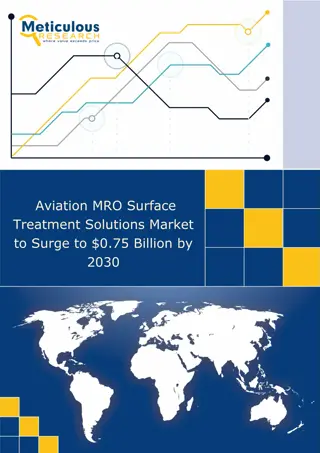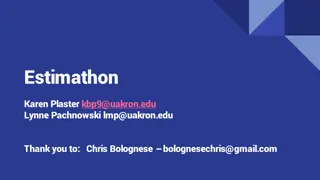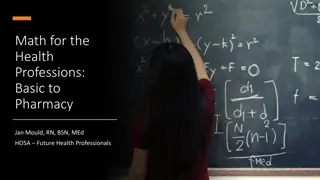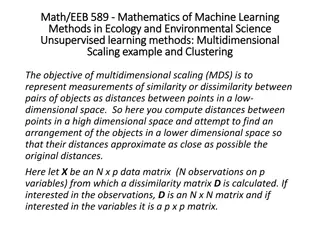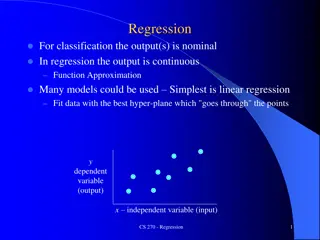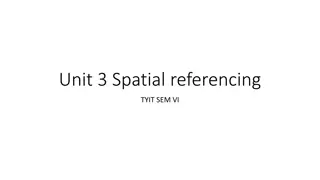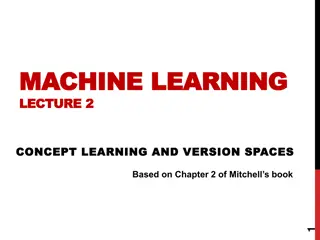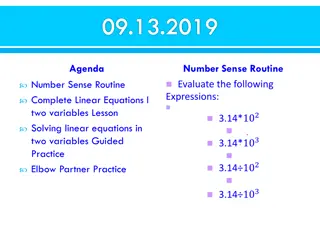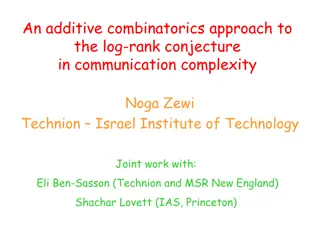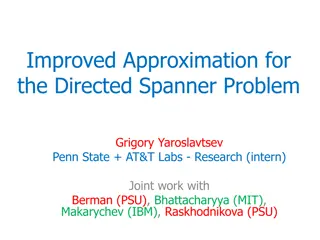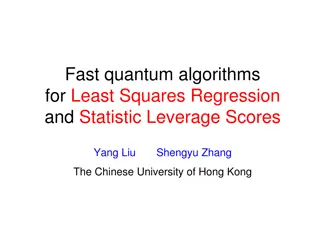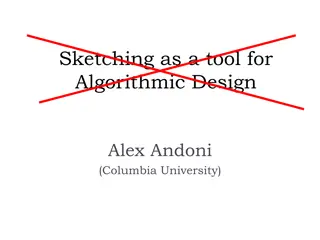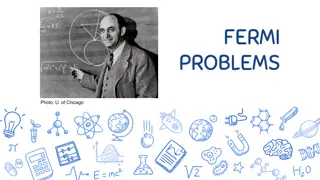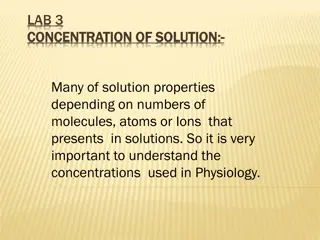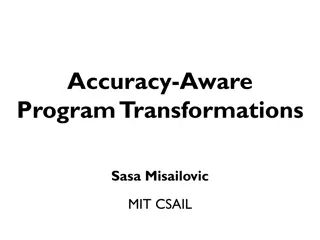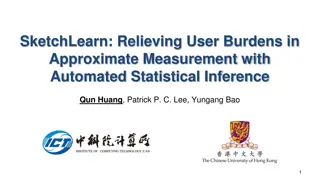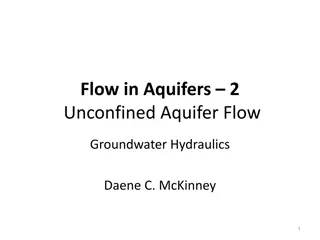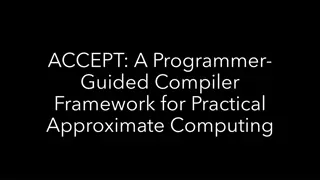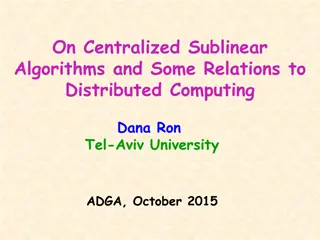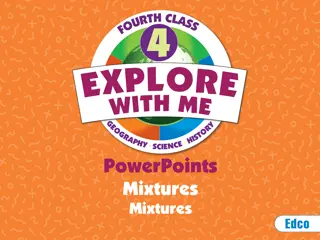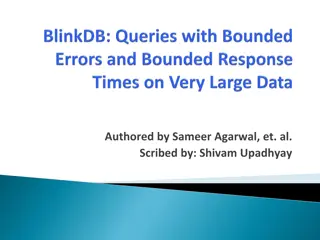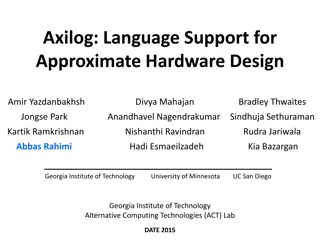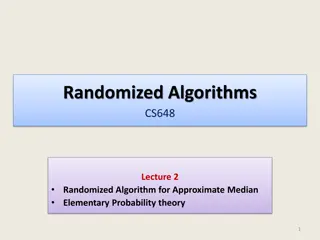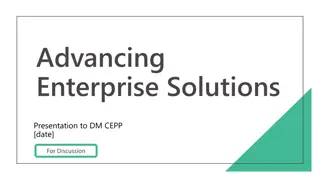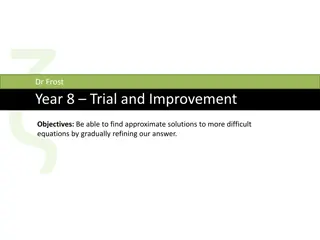Global Climate Models
Scientists simulate the climate system and project future scenarios by observing, measuring, and applying knowledge to computer models. These models represent Earth's surface and atmosphere using mathematical equations, which are converted to computer code. Supercomputers solve these equations to pr
3 views • 15 slides
Liver Transplant in India for treatment
Liver is the largest gland in our body, and an important metabolic organ which carries out many essential biological functions. The liver is a wedge-shaped, reddish-brown in color with two lobes of different size and shape. The approximate weight of a human liver is 1.5 kilograms. It is in the upper
5 views • 2 slides
Comprehensive IT & Security Solutions for Home and Business Needs
ONE STEP SOLUTION offers a range of IT services including computer sales & services, security solutions, CCTV surveillance systems, networking, fire alarm systems, and more. PROLOGIC SOLUTIONS provides reliable IT and security solutions for industrial and residential requirements, specializing in CC
1 views • 15 slides
Aviation MRO Surface Treatment Solutions Market
Meticulous Research\u00ae\u2014a leading global market research company, published a research report titled, \u2018Aviation MRO Surface Treatment Solutions Market by Surface Treatment (Anodizing Solutions, Chemical Treatment Solutions, Plating Solutions, Coating & Painting Solutions, Non-Destructive
8 views • 3 slides
Aviation MRO Surface Treatment Solutions Market to Surge to $0.75 Billion by 203
Meticulous Research\u00ae\u2014a leading global market research company, published a research report titled, \n\u2018Aviation MRO Surface Treatment Solutions Market by Surface Treatment (Anodizing Solutions, Chemical\n Treatment Solutions, Plating Solutions, Coating & Painting Solutions, \nNon-Destr
0 views • 3 slides
Rubber City MTC Estimathon: An Exciting Estimation Challenge!
Welcome to the first annual Rubber City MTC Estimathon where teams tackle 12 estimation problems within 30 minutes. The goal is to provide the closest approximate guess to the correct answer using minimum and maximum values. The smaller the correct ratio in each guess, the higher the score. Teams mu
0 views • 12 slides
Math Essentials for Health Professionals: Conversion and Equivalents
Comprehensive guide covering essential math concepts for health professionals, including conversions for length, weight, volume, and dosage calculations. Learn about unit conversions, approximate equivalents, and practical examples for real-world applications in healthcare settings.
0 views • 21 slides
Understanding Multidimensional Scaling and Unsupervised Learning Methods
Multidimensional scaling (MDS) aims to represent similarity or dissimilarity measurements between objects as distances in a lower-dimensional space. Principal Coordinates Analysis (PCoA) and other unsupervised learning methods like PCA are used to preserve distances between observations in multivari
2 views • 21 slides
Understanding Regression in Machine Learning
Regression in machine learning involves fitting data with the best hyper-plane to approximate a continuous output, contrasting with classification where the output is nominal. Linear regression is a common technique for this purpose, aiming to minimize the sum of squared residues. The process involv
1 views • 34 slides
Understanding Spatial Referencing Systems for Mapping
Spatial reference systems play a crucial role in defining geographic parameters and coordinate systems for mapping. They consist of components like orientation, latitude, longitude, and elevation, which help in representing spatial properties on maps. Reference surfaces such as the Geoid and ellipso
3 views • 13 slides
Understanding Binomial Theorem in Mathematics
Explore the Binomial Theorem in mathematics, covering Pascal's Triangle, binomial expansions, coefficients, general terms, and more. Learn how to expand binomials, analyze powers, find approximate numbers, and determine middle terms. Discover the structure of Pascal's Triangle and apply it to expand
0 views • 37 slides
Guidelines for Design of Cement Concrete Pavement and Interlocking Paver Blocks
This document provides guidelines for designing cement concrete pavements and interlocking paver blocks, covering factors governing design, wheel loads, design period, subgrade characteristics, approximate k values based on CBR values, and the importance of a sub-base below concrete pavements. It em
0 views • 67 slides
Understanding Parenteral Fluid Therapy and IV Solutions
This informative content explores the essentials of parental fluids therapy, including the indications, types of IV solutions (isotonic, hypotonic, hypertonic), and categories of intravenous solutions based on their purpose. It covers the significance of IV solutions containing dextrose or electroly
0 views • 37 slides
Understanding Concept Learning and Version Spaces in Machine Learning
In the field of machine learning, concept learning involves inferring general definitions of concepts from labeled examples. This process aims to approximate the best concept description from a set of possible hypotheses. The concept learning approach is illustrated through examples, such as predict
0 views • 18 slides
Quantum Query Complexity Measures for Symmetric Functions
Explore the relationships between query complexity measures, including quantum query complexity, adversary bounds, and spectral sensitivity, in the context of symmetric functions. Analysis includes sensitivity graphs, the quantum query model, and approximate counting methods. Results cover spectral
0 views • 19 slides
Understanding Linear Equations in Two Variables
Explore linear equations in two variables, solving systems of equations, graphing solutions, and determining types of solutions. Learn how to analyze and find solutions graphically, identify infinite solutions, no solutions, and unique solutions, and understand the concept of dependent systems. Disc
1 views • 35 slides
Understanding Time-Independent Perturbation Theory in Quantum Mechanics
Perturbation theory is a powerful tool in solving complex physical and mathematical problems approximately by adjusting solutions from a related problem with known solutions. This theory allows for more accurate approximate solutions by treating the difference as a small perturbation. An example inv
0 views • 19 slides
Additive Combinatorics Approach to Log-Rank Conjecture in Communication Complexity
This research explores an additive combinatorics approach to the log-rank conjecture in communication complexity, addressing the maximum total bits sent on worst-case inputs and known bounds. It discusses the Polynomial Freiman-Ruzsa Conjecture and Approximate Duality, highlighting technical contrib
0 views • 9 slides
Learning-Based Low-Rank Approximations and Linear Sketches
Exploring learning-based low-rank approximations and linear sketches in matrices, including techniques like dimensionality reduction, regression, and streaming algorithms. Discusses the use of random matrices, sparse matrices, and the concept of low-rank approximation through singular value decompos
0 views • 13 slides
Improved Approximation for the Directed Spanner Problem
Grigory Yaroslavtsev and collaborators present an improved approximation for the Directed Spanner Problem, exploring the concept of k-Spanner in directed graphs. The research delves into finding the sparsest k-spanner, preserving distances and discussing applications, including simulating synchroniz
0 views • 20 slides
Quantum Algorithms for Least Squares Regression
Quantum computing presents fast algorithms for solving least squares regression problems efficiently, offering solutions for overdetermined linear systems, matrix coherence, and regression computations. These algorithms leverage quantum mechanics to achieve computational speed-ups and approximate so
0 views • 17 slides
Sketching as a Tool for Algorithmic Design by Alex Andoni - Overview
Utilizing sketching in algorithmic design, Alex Andoni from Columbia University explores methodologies such as succinct efficient algorithms, dimension reduction, sampling, metric embeddings, and more. The approach involves numerical linear algebra, similarity search, and geometric min-cost matching
0 views • 18 slides
Fermi Problems and Estimation Techniques in Science
Understand Enrico Fermi's approach to problem-solving through estimation in science as demonstrated by Fermi Problems. These problems involve making educated guesses to reach approximate answers, fostering creativity, critical thinking, and estimation skills. Explore the application of Fermi Problem
0 views • 23 slides
Approximate Inference in Bayes Nets: Random vs. Rejection Sampling
Approximate inference methods in Bayes nets, such as random and rejection sampling, utilize Monte Carlo algorithms for stochastic sampling to estimate complex probabilities. Random sampling involves sampling in topological order, while rejection sampling generates samples from hard-to-sample distrib
0 views • 9 slides
Understanding Concentration of Solutions in Physiology
Concentration of solutions is crucial in understanding the properties of substances in Physiology. This involves concepts like percentage solutions and molar solutions, where the amount of solute is measured in grams or moles relative to the volume of the solution. Percentage solutions are commonly
0 views • 8 slides
Accuracy-Aware Program Transformations for Energy-Efficient Computing
Explore the concept of accuracy-aware program transformations led by Sasa Misailovic and collaborators at MIT CSAIL. The research focuses on trading accuracy for energy and performance, harnessing approximate computing, and applying automated transformations in program optimization. Discover how to
0 views • 20 slides
Metaheuristics and Hybrid Approaches in Multi-Objective Optimization
Multi-objective optimization involves solving complex problems with conflicting objectives, such as minimizing makespan and tardiness in flow shop scheduling. Pareto Optimal Solutions are sought, where improving one objective cannot be done without worsening another. Metaheuristics like S and P meth
0 views • 11 slides
Automated Statistical Inference for Approximate Measurement Burdens
SketchLearn explores relieving user burdens in approximate measurement through automated statistical inference. The research delves into addressing challenges such as specifying errors, defining thresholds, handling network traffic, and optimizing measurement algorithms. By identifying and mitigatin
0 views • 35 slides
Understanding Unconfined Aquifer Flow: Theory and Equations
Unconfined aquifer flow occurs above the water table with complexities in solving governing equations. Approximate solutions are derived for steady horizontal flow and Dupuit approximations in this type of aquifer.
0 views • 17 slides
ACCEPT: A Programmer-Guided Compiler Framework for Practical Approximate Computing
ACCEPT is an Approximate C Compiler framework that allows programmers to designate which parts of the code can be approximated for energy and performance trade-offs. It automatically determines the best approximation parameters, identifies safe approximation areas, and can utilize FPGA for hardware
0 views • 15 slides
Algorithm Strategies: Greedy Algorithms and the Coin-changing Problem
This topic delves into general algorithm strategies, focusing on the concept of greedy algorithms where locally optimal choices are made with the hope of finding a globally optimal solution. The discussion includes the nature of greedy algorithms, examples such as Dijkstra's algorithm and Prim's alg
0 views • 91 slides
Understanding Sublinear Algorithms and Graph Parameters in Centralized and Distributed Computing
Centralized sublinear algorithms and their relation to distributed computing are explored, emphasizing the efficiency of algorithms in processing large inputs in sublinear time. Examples of sublinear algorithms for various objects are provided, along with the computation and approximation of graph p
1 views • 34 slides
Approximate Hardware Synthesis for Energy-Efficient Designs
The paper introduces an Approximate High-Level Synthesis (AHLS) approach for generating energy-optimized register-transfer-level hardware implementations from accurate high-level C descriptions. This approach considers joint precision and voltage scaling to maximize energy reductions while maintaini
0 views • 20 slides
Understanding Mixtures: Types and Examples
A mixture is a combination of different ingredients that can be separated. There are various types of mixtures such as liquid solutions, solid solutions, and gas solutions. Liquid solutions involve solid substances dissolved in a liquid, like sugar in water, while solid solutions include metal alloy
0 views • 15 slides
Understanding BlinkDB: A Framework for Fast and Approximate Query Processing
BlinkDB is a framework built on Hive and Spark that creates and maintains offline samples for fast, approximate query processing. It provides error bars for queries executed on the same data and ensures correctness. The paper introduces innovations like sample creation techniques, error latency prof
0 views • 8 slides
Approximate Computing in Hardware Design: A Comprehensive Overview
Explore the groundbreaking concepts of approximate computing in hardware design, which involves embracing errors to enhance resource efficiency and performance. Delve into topics such as avoiding worst-case design, criteria for approximate HDL, safety in hardware, and relaxing accuracy requirements
0 views • 31 slides
Randomized Algorithms for Approximate Median with Elementary Probability
This content covers a lecture on a randomized algorithm for finding an approximate median element using elementary probability theory. It discusses the importance of insight and basic probability in designing and analyzing such algorithms. The lecture presents a simple probability exercise involving
0 views • 25 slides
Sequential Approximate Inference with Limited Resolution Measurements
Delve into the world of sequential approximate inference through sequential measurements of likelihoods, accounting for Hick's Law. Explore optimal inference strategies implemented by Bayes rule and tackle the challenges of limited resolution measurements. Discover the central question of refining a
0 views • 29 slides
Advancing Enterprise Solutions Presentation for Discussion
This presentation focuses on advancing enterprise solutions within the Government of Canada, particularly in the context of whole-of-government approaches and digital transformation. It discusses the importance of a holistic enterprise approach, governance solutions, and how enterprise is addressed
0 views • 17 slides
Practice Trial and Improvement Method in Equations
Enhance your skills in finding approximate solutions to equations through trial and improvement methods. Understand the concept of number lines, inequalities, and how to refine answers gradually. Practice solving equations by testing different values and determining the most accurate solutions. Expl
0 views • 10 slides




